Follow Me
Latest Posts
- Organize Your Desktop with Your Perfect Desk Pad: 2025 Update
- How to Use Timers for Improved Productivity — Part 5: Hybrid Timers and Bonus Material
- How to Use Timers for Improved Productivity and Focus — Part 4: Digital Timers
- How to Use Timers for Improved Productivity and Focus — Part 3: Tangible Timers
- How to Use Timers for Improved Productivity and Focus — Part 2: Pick the Right Timer
Search Best Results Organizing
Subscribe to the Paper Doll Blog via Email
Paper Doll’s 23 Ideas for a More Organized & Productive 2023
Posted on: January 2nd, 2023 by Julie Bestry | 14 Comments
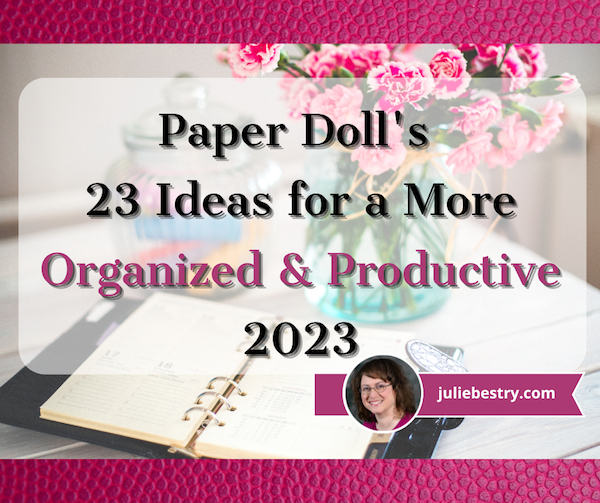
Happy New Year! And welcome to GO (Get Organized) Month 2023, where we celebrate efforts to make our spaces more organized and make ourselves more productive.

We in the National Association of Productivity and Organizing Professionals (NAPO) love this opportunity to help you make this year your best. To that end, today’s post offers up 23 ideas for achieving what you want this year in your space, schedule, and life.
CREATE A FRESH MINDSET
1) Learn last year’s lessons to build next year’s success.

You were probably super-busy last week, but I encourage you to read the final Paper Doll post of 2022. (Trust me, it was a good one!)
Organize Your Annual Review & Mindset Blueprint for 2023 is full of questions and resources for figuring yourself (and your last year) out.
I often joke to clients that while I’m not a mental health professional, I am like a marriage counselor between you and your stuff. Well, last week’s post is like a cross between a therapy session and a deep dive with your BFF. It rejects the demoralizing proposition of resolutions in favor of creating a fresh, motivating mindset for the coming year, whether with a word, quote, or motto of the year, and uses signage, a vision board, or a music playlist to keep your eyes on the prize that is your new and improved life.
2) Don’t take my word for it. Listen to James Clear.
If you’ve been paying attention to the news in the “habit” realm at all in the last few years, you know that James Clear wrote Atomic Habits: An Easy & Proven Way to Build Good Habits & Break Bad Ones, a book that takes the research of habit researchers (like Charles Duhigg in his The Power of Habit) and makes it all actionable.

Theory is good, but what most of us want is someone to tell us how to do it, and preferably in a way that doesn’t make us hungry, cranky, poor, or frustrated. Clear delivers.
But this year, he’s doing something special. Clear is offering a free email course called 30 Days to Better Habits: A simple step-by-step guide for forming habits that stick.
It’s not a bootcamp. Rather, as Clear explains, “Habits are not a finish line to be crossed, they’re a lifestyle to be lived.” Over eleven emails (after an introduction), one sent every three days, he’s going to gently teach principles to help cultivate a new lifestyle (and not merely a set of “tasks you can sprint through during a 30-day challenge.”)
There’s also an 18-page PDF workbook and a Google spreadsheet with more than 140 examples (!) of how to implement the strategies in the course and apply them to different habits.
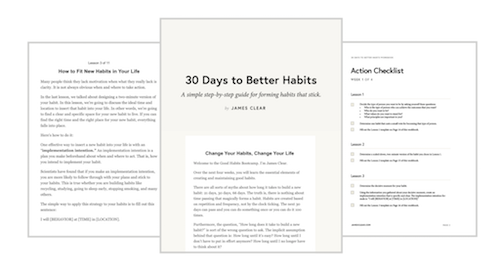
The course is based on Atomic Habits, but he notes that you don’t need the book to successfully complete the course. However, because I originally read a library copy, I decided to buy my own, because he’s also got a nifty set of bonus packages for those who do buy the book. Basically, you email a copy of your receipt or other proof of purchase, and you get:
- Bonus Guide: How to Apply Atomic Habits to Business
- Bonus Guide: How to Apply Atomic Habits to Parenting
- The Habits Cheat Sheet
- Companion Reading Guide email series
- Habit Tracker
For what it’s worth, I bought my copy New Year’s morning, and had received the bonuses by the time I had lunch!
3) Make strides towards delight, too!
One of my favorite sites is the UK-based Action for Happiness. Each month, they put out a stellar calendar of tiny (Clear might even call them atomic) actions you can take toward a better life. Each month is themed, and you can find daily reminders on their Instagram, Twitter, and Facebook accounts.
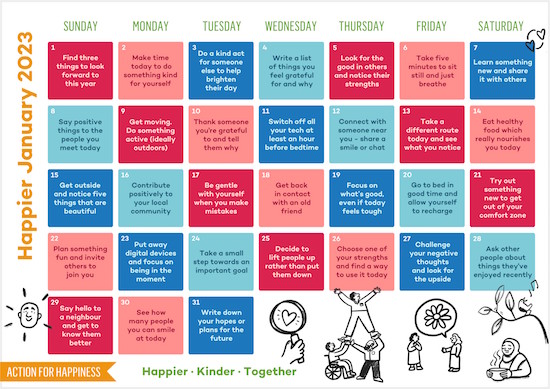
January 2023’s theme is Happiness, and on New Year’s Day, the assignment was to “Find three things to look forward to this year.”
If you’re wondering what happiness has to do with organizing and productivity — hi, you must be new here!
But seriously. Clutter — all the excess stuff in our spaces, in our schedules, and in our brains — wears us down. It’s not at all uncommon for clients to be dealing with clinical depression or anxiety disorders, and disorganization and lack of productivity (and the stress of toxic productivity), only contribute to greater unhappiness. Think of these daily themes less as homework (“I have to”) and more as opportunities (“I get to”) on the path to organizing your mental health.
4) Collect good days — literally!
Each day, make a habit of writing down something great that happened. You can consider this part of (or instead of) a gratitude practice.
Our lives fill up with what we give our attention, so let’s pay attention to the good stuff. Next year, when you’re doing your annual review, you’ll have a tangible resource for looking back on the year and see the highlights, what you considered valuable at the time, and what might have been forgotten had you not made a notation.
Our lives fill up with what we give our attention, so let's pay attention to the good stuff. Share on XCreate a spreadsheet, an Evernote note, a pretty notebook, or — and this is my favorite idea — a Jar of Joy! (Someone else came up with the concept, but I came up with the name. Write a few words or a sentence about whatever great thing happened on a slip of paper. Fold or roll it up, and toss it in a jar or glass canister. Consider using colored slips of paper to make the contents look prettier, and keep your Jar of Joy visible, so you can be reminded each day that good things are happening!
5) Remember that tiny tasks count toward a more productive life.
There’s a reason why James Clear (and, ahem, Paper Doll) believes that those teeny, tiny steps lead to success. Whatever you want to achieve, whatever goals you have, I’d like to encourage you to figure out the teeniest, tiniest, itsy-bitsyist thing you can do to get yourself microscopically closer to the finish line…heck, to the starting line.
Adam Bulger at Fatherly.com came up with 27 Life-Changing Micro Habits That Require Only A Few Minutes. Many of the habits on this list take less than a full minute to accomplish. I liked item #23 on his list:
Always put one thing away before you leave whatever room you’re in. If you’re overwhelmed by clutter, you feel like you don’t have time to clean but habitually chipping away at the mess, one piece at a time, can make it more manageable.
— Liz Fosslien (@fosslien) June 28, 2022
START PLANNING YOUR YEAR
6) Select your planning system.
If you’re a digital person, your calendar is a continuous scroll of everything you’ve got planned. But if you’re a paper planner person (try saying THAT three times quickly!), you may have delayed getting a planner out of fear of buying the wrong one, or perhaps you’ve just not written in what you did buy, because you “don’t want to mess it up.”
It’s your planner. You can fill it in with crayons and use scratch-&-sniff stickers, and it’ll be OK. Whatever inspires you to log your meetings and appointments, block your time, and work toward your deadlines is fine with me. (And if anyone gives you guff, send them to Paper Doll. I’ll set them straight!)
If you’re still struggling with how you’ll plan your 2023, go visit Paper Doll’s Guide to Picking the Right Paper Planner. It covers the features you need to consider in a planner (including whether you’re better off with digital or paper), as well as pointing out some of the best options.
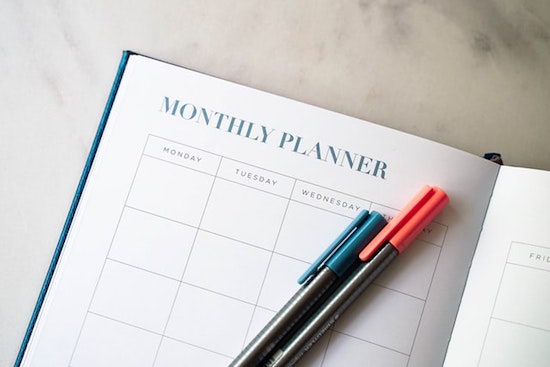
The key to organizing your life is being able to visualize your time. So get everything out of your head and in front of your beautiful eyeballs.
7) Move into your new planner now.

Make a cup of cocoa, grab last year’s planner or pull up your digital calendar (using two screens, like your computer and your phone simultaneously) — compare apples-to-apples.
Go page-by-page through last year’s schedule and copy over everything that recurs on the same dates, like birthdays and anniversaries. Digital users can skip this step.
Next, add events that happened last year and are already scheduled to happen again, but not on the same dates (like conferences, work retreats, mammograms, dental appointments, etc.).
Use last year’s calendar to help prompt you to make a list of everything you need to schedule or add to your long-range tasks, like setting an appointment with your CPA to discuss tax issues.
8) Don’t forget to plan time for your activities.
Appointments aren’t everything. Make time in your schedule for thinking, doing your creative work, attending to self-care, and so much more. Whenever clients complain to me that they don’t have time to accomplish something that they swear is important to them, I ask them to show me where they’ve put it on their schedules. [Insert cricket noises here.]
The truth is that if you don’t prioritize something by making time for it, it’s not really a priority to you. Treat yourself with the same respect you’d treat your boss or your best client or your Grandma, and make time for what matters:
Struggling To Get Things Done? Paper Doll’s Advice & The Task Management & Time Blocking Virtual Summit 2022 (I’ll have news about the 2023 summit coming soon!)
Playing With Blocks: Success Strategies for Time Blocking Productivity
Organize Your Writing Time for NaNoWriMo 2022 (Even though the post is ostensibly about making time to write, it’s applicable to make time for anything you value.)
9) Nurture your commitment to your planning system…every day.
If there’s so much going on in your life that you forget to check your planner or digital calendar and task system until it’s too late, upgrade your accountability support:
- Set an alarm on your phone to ring at around 5 p.m. daily to remind you to check your calendar and tickler file for the next day and the coming week.
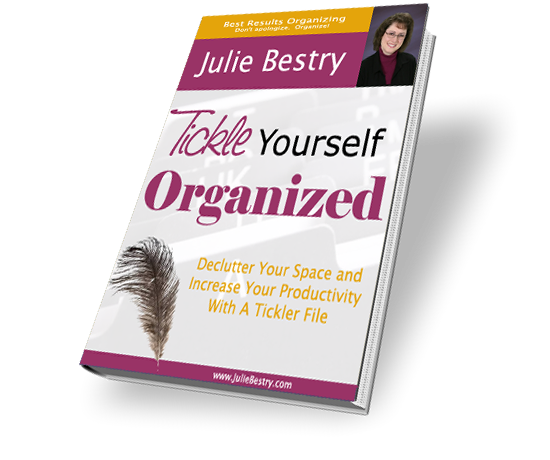
- If you have an assistant (especially if you both work remotely) schedule time each day to review newly-added appointments and obligations.
- Have a family meeting on the weekend to make sure every appointment and school pick-up is covered.
- Schedule your next appointments before leaving anyplace you visit intermittently (doctor, dentist, massage therapist, hair or nail salon, etc.) — but only if you have your calendar with you. Otherwise, ask them to call you. Never agree to any date without your planner nearby. In fact, if you tend to agree to too much, say that your professional organizer told you that you’ll have to wait to check your schedule before taking on any new obligations. (Blame me; I won’t tattle.)
10) Know where your time is going — before it gets away from you!
It really doesn’t help you schedule all of the things you’re supposed to be doing if you don’t have a handle on what you’re actually doing. To that end, Laura Vanderkam is doing something nifty.
You may know Laura from her podcasts, her blog, or her several books, including 168 Hours: You Have More Time Than You Think, Off the Clock: Feel Less Busy While Getting More Done, and the recently published Tranquility By Tuesday: 9 Ways to Calm the Chaos and Make Time for What Matters.

Laura is running the 168 Hours Time Tracking Challenge — and yes, I signed up for this one, too. I’ve always enjoyed Laura’s writing, but when we both participated in the 2022 Task Management and Time Blocking Summit, I really got to peek behind the curtain to see how she thinks about time and our use of it. She’s talking about time concepts and strategies that are too rarely discussed.
The 168 Hours Time Tracking Challenges doesn’t start until the middle of next week, January 9, 2023, so there’s still time to sign up. After signing up, you’ll get links to resources and suggestions for tracking your time on paper (via Laura’s time sheets) or digitally, as well as links to her other writings on the subject.
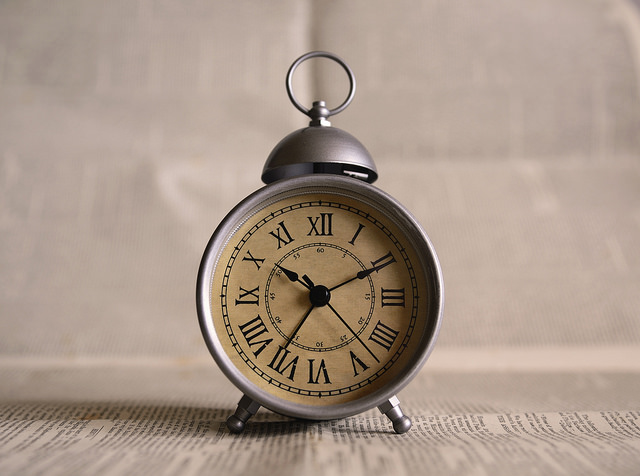
Like tracking what you eat (which can be emotionally distressing), tracking what you do with your time can be uncomfortable. When you realize you’re spending 3 hours a day on social media — and your job is not as a social media influencer — you may be upset. But if you recognize that you’re spending 90 minutes (or more) of every day “making do” with software that keeps freezing or helping a co-worker who takes advantage of your kindness, you’ll become more aware of challenges you can then overcome!
BECOME YOUR OWN MONEY HONEY
11) Make a TAX PREP folder. Actually, make two.
Tax season has started. Within a matter of weeks, your mailbox will start filling up with W-2s and 1099s, and you’ll need to keep them safe. At the very least (if you haven’t done it already), create a folder with a simple name like 2022 Tax Prep.
Look around for all of your tax-deductible receipts and charitable donation paperwork, and pop those in; when forms start arriving in the mail, put those in, too. Some of your important tax forms may come by mail; others, like your investment accounts or health insurance annual summary, might live in your online accounts, requiring you to log in.
This one two-minute task will save you so much time down the road. And time is money, so whether you do your own taxes or hand things off to a CPA, you’ll be saving the Benjamins as well as the clock-hours.
You don’t have to get fancy. A manila folder set in the front of your financial files is fine; or get a dedicated accordion folder like the Smead All-in-One Income Tax Organizer.

12) Stop hiding from your financial truths.
You have to answer mail call! Not looking at your bills when they come in the mail (or email) is like ignoring a pain that gets worse and refusing to go to the doctor because you’re afraid of bad news. Financial ills don’t go away on their own.
Not looking at your bills when they come in the mail (or email) is like ignoring a pain that gets worse and refusing to go to the doctor because you're afraid of bad news. Financial ills don't go away on their own. Share on XWhy not start bossing your money around instead of letting it bully you?
Over the course of the next few weeks, get in the habit of putting your bills and statements all in one place, like a folder next to your computer. If you normally just get a reminder to log in and pay a bill, make a point of downloading and/or printing out your monthly statement.
Make a list of all of your credit cards, loans, and other debts, as well as their balances and interest rates. Seeing it in black and white is the first step toward taking control of your financial future.
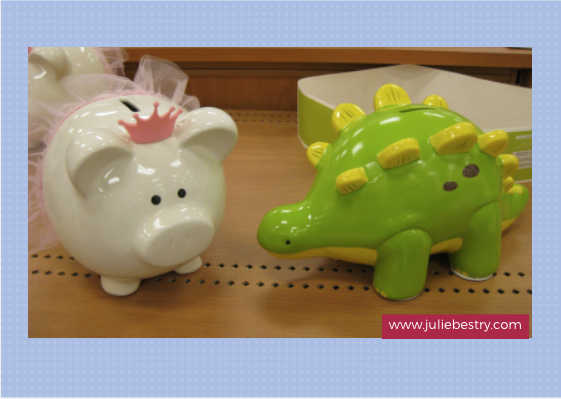
13) Get a financial accountability partner!
Last year, I said, “If you don’t know the difference between an NFT and BBQ…” It turns out a lot of people were investing in NFTs and cryptocurrency when they would have been better off having a backyard barbecue and inviting their friendly neighborhood fee-only Certified Financial Planner.
I’m no expert in cryto-currency. (And your brother-in-law’s cousin almost assuredly isn’t!) But whether you want to know whether you invest more in your 401K or your IRA, a fee-only CFP can help you out when your eyes start to glaze over. You pay for their expertise, and they give you unbiased advice because fee-only CFPs don’t get any commissions on investments you make.
Does thinking about investment vehicles feel like choosing between between becoming a rock star or an NBA star (because of their equal improbabilities)? If you need support and strategies for getting your bills paid on time, every time, there are NAPO members who are financial organizers; you can also find a Daily Money Manager through the American Association of Daily Money Managers (AADMM).
BECOME A VIP WITH YOUR VIPs
14) Get your vital documents in order.
It’s a sad fact of life that people get sick or incapacitated, and sometimes shuffle off this mortal coil far too soon. Whether it’s illness or natural disasters or some other kind of calamity we don’t want to think about, we need to get our affairs in order. And that means getting paperwork straight.
Check in with these posts for step-by-step guidance to making sure you’re covered with up-to-date vital documents and a way to keep them organized.
- A New VIP: A Form You Didn’t Know You Needed — If you or anyone in your life is in Medicare, please make sure you read and act on this post! This is not one that you should put off.
- Ask Paper Doll: Do I Really Need A Safe Deposit Box?
- How to Replace and Organize 7 Essential Government Documents
- How to Create, Organize, and Safeguard 5 Essential Legal and Estate Documents
- The Professor and Mary Ann: 8 Other Essential Documents You Need To Create
- Protect and Organize Your COVID Vaccination Card
15) Put your foot on the brake before automatically renewing your car insurance.
If you haven’t shopped insurance to compare prices and coverage in recent years — or ever — this is really the time to do it.
This year, I updated an older post that explained all of the elements of auto insurance, as well as how and where to organize your paperwork.
Organize for an Accident: Don’t Crash Your Car Insurance Paperwork [UPDATED]
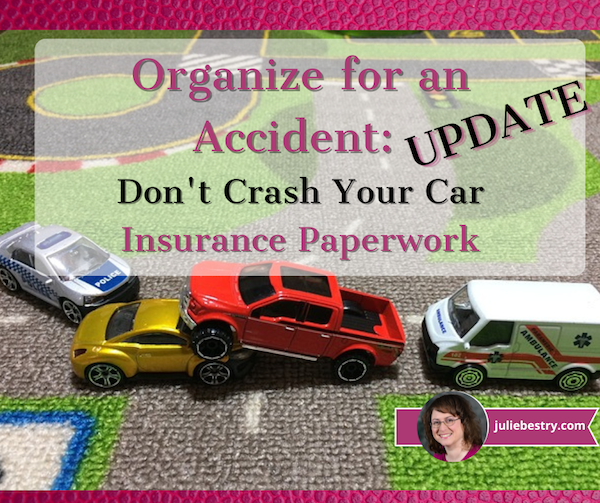
But the post also talks about the wisdom of comparison shopping. While you’re at it, shop around for homeowners’ or renters’ insurance, as well. Why not organize some discounts while you’re organizing your paperwork?
16) Clean out your wallet and make an inventory.
You’ve probably got too much in your wallet. If you keep it in your purse, it’s giving you shoulder pains; if it’s in your back pocket, you’re likely misaligning your spine. Why not take a lunch hour and declutter your wallet, and then put it all back so it makes sense to you?
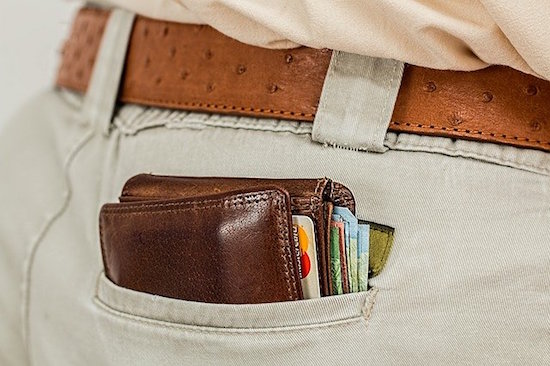
While you’re at it, this is the perfect time to take an inventory of the licenses, insurance cards, and debit/credit cards you have in there and all the information contained on them.
Pull everything out of your wallet, make two columns of cards on the table, and take a photo with your smartphone. Then flip each card over in the same position, and photograph the back. Easy-peasy. (If you’ve got a home scanner/copier, it’s fine to use that, but I’ll discourage you from using a public copier; it’s too easy for someone to surreptitiously snap photos of your information over your shoulder.)
Remember to password-protect the document on your phone or in your cloud back-up.
EMBRACE PAPER DOLL‘S CLASSIC PRINCIPLES ABOUT ORGANIZING
17) Follow the Ice Cream Rule.
I tell my clients, “Don’t put things down, put them away.” The word “away” assumes you’ve already got a location in mind. But good organizing systems have two parts: the where & the how.
When you bring groceries home, you put the ice cream away in the freezer immediately to keep from having a melted, sticky mess. It’s pretty rare for someone to put away the toilet paper or breakfast cereal before the frozen foods. The freezer is the “where” but putting the ice cream away first is the “how.” It’s so innate, you don’t even think about. But for most of your stuff, including papers, you do have to think about it.
Whatever comes into your space, when you go shopping, or even when things are free, decide on a home before you bring it in.
Once it’s in your space, build fixed time into your schedule for how/when you’ll deal with maintaining it or getting it back to where it lives. When will you do laundry? When will you file financial papers? What will be your trigger — when the laundry basket or in-box is full, or will you put it on your calendar?
Remember: “Someday” is not a day on the calendar.
18) Everything should have a home, but not everything has to live with you.
Clients are often so focused on organizing what they already have that they ignore a key truth: not everything you own needs to stay with you forever.
If it’s broken and you’re not willing to spend the time or money to repair it, let it go. If you’re sentimentally attached to something that’s outdated or takes too much space or effort to keep, take a photo of you holding it or wearing it. Then set it free!
If you have piles and files full of clippings and articles you haven’t looked at in years, you’re not alone. 80% of what gets filed is never accessed again. Trust that the internet is a vast storehouse of everything you’d want to look up, and if the paper you’re holding has nothing to do with you, personally, or reflects information you’ve long since learned by heart, recycle it and give yourself space.
19) Don’t fight clutter with more clutter.
I love The Container Store and all the office supply stores as much as every other professional organizer. (Really!)
But buying oodles of storage containers — bins, boxes, tubs, and shelves — can only help you organize if you pare down to what you need and want.
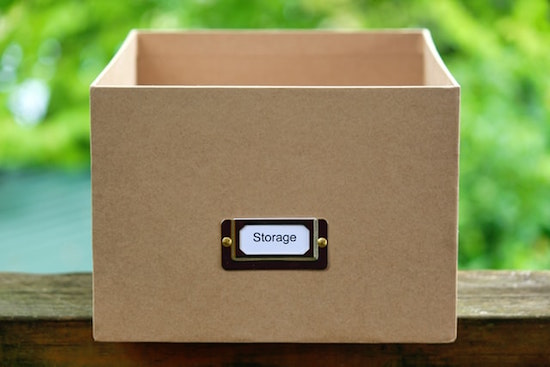
Photo by Lia Trevarthen on Unsplash
When you see a great outfit at the store but it’s not in your size, you shouldn’t say, “Hey, I’ll buy this now and then lose (or gain) 30 pounds to fit into it.” Even if you do declutter the personal poundage, you never know from where, exactly, that weight will disappear. It almost certainly won’t be a perfect fit.
I’m not saying never to acquire storage containers (adorable or otherwise), but do it last. Once you pare down, pick colorful, fun containers that suit your needs, space, and tastes.
20) Take baby steps. Declare small victories. Don’t feel like you have to do it all.
When it comes to clutter, it’s not the space it takes up in your house, it’s the dent it puts in your life! If you’re late every day because you can’t find your keys and your kids can’t find their homework, it’s a much bigger deal than a cluttered guest room closet or drawers of old birthday party pictures that haven’t been scrapbooked.
Focus on your biggest daily stressors, break them down into small, actionable steps, and solve those first. You don’t need to do it all at once, but if you develop a habit of doing a little bit at a time, once your space is straightened up, maintenance will feel natural.
What you don’t do is just as important as what you do. pic.twitter.com/sE6BrMyUAm
— Sarah Arnold-Hall (@saraharnoldhall) November 6, 2022
21) Declare bankruptcy on clutter debt.
Give yourself permission to declare bankruptcy on the “debt” of unread magazines, charitable contribution requests that aren’t really your cause, unworn clothes three sizes too small, or email from last July. In the words of Elsa, LET IT GO!
Keeping something just because you spent money on it or because it was a gift doesn’t make it any more valuable or useful; it just ends of costing you time (dusting or caring for it), space (that you could use for more important things), or money (spent on dry-cleaning or storage rental).
Keeping something just because you spent money on it or because it was a gift doesn't make it any more valuable or useful; it just ends of costing you time, space, & money. Free up the mental energy! Share on X22) Hire a professional organizer.
As a Certified Professional Organizer®, I see how much my clients get out from support to make difficult decisions and develop systems to surmount those challenges. Find a professional organizer near you (or a virtual organizer) by using NAPO’s search function. You may also want to consult with our colleagues in the Institute for Challenging Disorganization.
Whether you need to reinvigorate a closet, learn how to use Evernote to get your productivity zipping along, or downsize Grandma’s house so she can move to Boca, professional organizers can show you the way. We’re not just experts in organizing stuff, but experts in helping you figure out how best to organize your ways of thinking and living.
23) Be gentle with yourself.
Getting organized and being productive is a constant battle between your goals and other people’s expectations of you. Focus on what you need and want.
In the words of Mary Oliver poem The Summer Day, “What is it you plan to do with your one wild and precious life?”
The purpose of organizing and being more productive is to make your life easier — so that you can spend it doing the things you like with the people you love.
Happy New Year! Happy GO Month!
Paper Doll Post:




Well, this is just a fabulous list of ideas. I’m resonating with so many of your tips.
For example, your ice cream rule, and the idea of knowing where you will put things before you buy them. I have this thought every time I see GIANT stuffed animals in stores. If they look big in a large store, imagine how they will take over a room in your house.
I also keep a gratitude journal, and it is so great to start the day focusing on what has gone well, on what prayers God has already answered (even some I never thought to ask!). Being positive makes a huge difference in how we experience the day.
Happy new year!
Oh, Seana, thank you for your kind words! This is a mix of my classic advice and resources I’ve recently found, and once I started, I couldn’t stop.
And the giant stuffed animals remind me of how I always wonder how people are able to figure out if Christmas trees will fit in their homes, because who is actually measuring them at the tree lot. (Aren’t they just eyeballing them?) At least you can, I guess, lay a stuffed giraffe down and pull out your measuring tape!
I’m so glad your gratitude practice works so well for you! Thanks for reading!
Excellent post, as usual, Julie. Great actionable tasks for anyone who doesn’t know where to start.
Accordion folders are effective for organizing all the tax paperwork. Subdividing into categories like income, deductions, charity, etc… will make it much easier for that meeting with your accountant.
Thanks for reading and for your kind words, Sabrina. Actionable and tiny were the watchwords for today!
I love accordion folders, too, though they might be overkill for people who only have a half a dozen supporting documents each year. For people without businesses, so few receipts are applicable nowadays! But for people with lots to deduct, an accordion folder is a perfect way to keep things organized and self-contained.
This post is rich with ideas. I love it. Sharing with my friends who don’t have goals set yet.
Thanks, Jamie! I think there a lot of people who are too busy with the holidays to consider an annual review or goal-setting until the new year starts. Thanks for reading and for sharing! Happy New Year!
Wow, Julie. You covered so many wonderful topics in this post. As Seana said, so much of what you covered hits home for me. I am definitely going back to read your last blog post. I’m a James Clear fan, too!
I keep a journal to remind me of things that went well and for which I’m thankful and also to remind myself of things I want to do better. I can’t improve if I don’t recall where I made a mistake.
You know me, Diane — so many words! (You should see how much I cut out!) And I’m delighted that you’ll be going back to read last week’s post, because I know you were enjoying your week off.
Yes, James Clear is fabulous. I’ve been getting his weekly newsletter for years, and he’s the one (male) writer on productivity whom I feel sees all the obligations people have and doesn’t focus solely on work as if everyone has a wife who can pick up the slack.
Your journal sounds like a superior tool for you!
I love the Happiness Calendar – I’ve never seen anything like that before.
I’m not sure how long they’ve been doing it, but I’ve been following them on Twitter for at least six or seven years, and I think they’ve been doing the calendar most of that time. I see a reminder in my feed at least once a day, and the daily assignments always resonate with me.
Thanks for reading!
Best quote for the end – The purpose of organizing and being more productive is to make your life easier — so that you can spend it doing the things you like with the people you love. People are what makes life so wonderful. I’m also checking out the action for happiness link.
I’m really glad you liked my final quote. That’s how I’ve been ending my presentations for the last two decades! It’s my signature signoff!
Thanks for reading!
There’s so much ‘behind the scenes’ work that goes into changing habits and achieving goals. This is a very helpful set of questions / tips to help people start out in a way that makes them more likely to achieve what they want. Thank you for putting this together.
Thanks so much for reading, and I agree, there’s a type of plate-juggling to put all the moving elements of changing behavior to yield success. I think we forget to do the deep-thinking and analysis that helps us achieve those results.